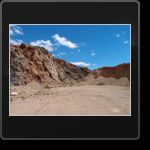The El
Conjuro Mines consist of several areas: El Conjuro, San Adolfo, San Augusto,
Oportunidad, Virgen de las Angustias, Santa Elisa, Complemento, La
Última. The deposits are spread out through the neighbouring areas of
Almegíjar, Cástaras and La Taha, but the main site is located in
Busquístar. The minerals are goethite, hematite, lepidocrocite,
todorokite, rancieite and barite.
The mines originate from time of the
Moor's and it is then that the first mining took place for the extraction of
iron. However, it wasn't until 1895 when a banker from Madrid, Adolfo Bayo
commissioned a mining engineer Stéphen Czyszkowski to survey the mines
properly. The results where very promising and subsequently in 1899 the mines
were sold to the French company Schneider et Cie., a subsidiary of El Creusot,
for three million francs.
The development of the mines was hampered by
the difficulty of transport access and eventually a railway was built to
overcome this issue. However, this was constantly eroded and damaged by the
landslides in the area due to heavy rain and wasn't that successful.
In
1954 the ownership of the mines was transferred to Minas de Hierro from El
Conjuro, SA, of Ensidesa, and ore was supplied to the blast furnaces of
Avilés. In 1956, the Ministry of Industry authorized the installation of
an aerial rope haulage system, which entered into service in 1957. The aerial
ropeway took a 18km route from the loading hoppers some 200m from the mine to a
loading dock which can still be seen today at the Rules dam. From here the ore
was then transported by trucks to the port of Motril.
The mines began
to struggle in 1964 as the reserves of ore first documented at the turn of the
century failed to materialise. The aerial cable that had been used to transport
ore was frequently damaged and unusable due to the high winds present in the
area resulting in many tub derailments. In 1974, mining operations stopped.
Some 3 million tonnes of ore were extracted during the last 2 decades, but this
fell short of expected amounts.
Currently (2018) a small amount of
aggregates is extracted from the south side of the mine site. The whole site is
an open cast mine, with a number of large benches still in place. Around the
mine there are a number of buildings including the mine offices, weighbridge,
and large ore hoppers that locate the start of the aerial ropeway. The
University of Granada recently bought the whole site to study the growth of
plants in iron rich soils.
|
